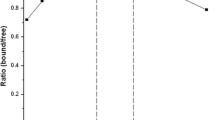Abstract
The involvement of G proteins in receptor mediated astroglial cAMP formation was studied. Isoproterenol or prostaglandin E2 stimulated adenylate cyclase of primary astroglial cells was inhibited by somatostatin. Preincubation, of cells with increasing concentrations of islet activating protein (IAP) diminished somatostatin inhibition of adenylate cyclase. At an IAP concentration of 50 ng/ml somatostatin inhibition was completely abolished. Studies on IAP catalyzed32P-ADP-ribosylation of astroglial cell particulate material revealed an incorporation of radiolabel into three polypeptides in the molecular weight range of 41,000–39,000 Dalton. Pretreatment of intact cells with IAP reduced radiolabeling of this molecular species in a concentration dependent manner. No further radiolabeling above background level was detectable after pretreatment of cultures with 10 ng IAP/ml or more. At present, the occurrence of at least three IAP substrates (G proteins) does not permit an identification of the somatostatin receptor coupled G protein. Rather, the finding reveals that astrocytes are endowed with multiple variants of GTP binding proteins likely to be coupled to different receptors.
Similar content being viewed by others
Abbreviations
- cAMP:
-
cyclic adenosine monophosphate
- DPBS:
-
Dulbecco's phosphate buffered saline
- DTT:
-
dithiothreitol
- IAP:
-
islet activating protein=pertussis toxin
- PG:
-
prostaglandin
References
van Calker, D., and Hamprecht, B. 1980. Effects of neurohormones on glial cells. Pages 32–67,in Fedoroff, S. and Hertz, L. (eds.), Adv. in Cell. Neurobiol., Academic Press, New York.
van Calker, D., Muller, M., and Hamprecht, B. 1980. Regulation by secretin, vasoactive intestinal peptide, and somatostatin of cyclic AMP accumulation in cultured brain cells. Proc. Natl. Acad. Sci. (U.S.A.) 77:6907–6911.
Evans, T. E., McCarthy, K. D., and Harden, T. K. 1984. Regulation of cyclic AMP accumulation by peptide hormone receptors in immunochemically defined astroglial cells. J. Neurochem. 43:131–138.
Aktories K., Schultz, G., and Jakobs, K. H. 1983. Adenylate cyclase inhibition and GTPase stimulation by somatostatin in S49 lymphoma cyc- variants are prevented by islet-activating protein. FEBS Lett. 158:169–173.
Reisine, T., Zhang, Y.-L., and Sekura, R. 1985. Pertussis toxin treatment blocks the inhibition of somatostatin and increases the stimulation by forskolin of cyclic AMP accumulation and adrenocorticotropin secretion from mouse anterior pituitary tumor cells. J. Pharm. Exp. Ther. 232:275–282.
Koch, B. D., Dorflinger, L. J., and Schonbrunn, A. 1985. Pertussis toxin blocks both cyclic AMP-mediated and cyclic AMP independent actions of somatostatin. J. Biol. Chem. 260:13138–13145.
Gilman, A. G. 1984. G proteins and dual control of adenylate cyclase. Cell 36:577–579.
Dolphin, A. C. 1987. Nucleotide binding proteins in signal transduction and disease. Trends Neurosci. 10:53–57.
Kurose, H., Katada, T., Amano, T., and Ui, M. 1983. Specific uncoupling by islet-activating protein, pertussis toxin, of negative signal transduction via α-adrenergic, cholinergic, and opiate receptors in neuroblastoma X glioma hybrid cells. J. Biol. Chem. 258:4870–4875.
Murayama, T., and Ui, M. 1983. Loss of the inhibitory function of the guanine nucleotide regulatory component of adenylate cyclase due to its ADP ribosylation by islet-activating protein, pertussis toxin, in adipocyte membranes. J. Biol. Chem. 258:3319–3326.
Booher, J., and Sensenbrenner, M. 1972 Growth and cultivation of dissociated neurons and glial cells from embryonic chick, rat and human brain in flask cultures. Neurobiology 2:97–105.
Keller, M., Jackisch, R., Seregi, A., and Hertting, G. 1985. Comparison of prostanoid forming capacity of neuronal and astroglial cells in primary cultures. Neurochem. Int. 7:655–665.
Tihon, C., Goren, M. B., Spitz, E., and Rickenberg, H. V. 1987. Convenient elimination of trichloroacetic acid prior to radioimmunoassay of cyclic nucleotides. Anal. Biochem. 80:652–653.
Ortmann, R. 1978. Effect of PGI2 and stable endoperoxide analogues on cyclic nucleotide levels in clonal cell lines of CNS origin. FEBS Lett. 90:348–352.
Lowry, O. H., Rosebrough, N. J., Farr, A. L., and Randall, R. J. 1951. Protein measurement with Folin phenol reagent. J. Biol. Chem. 193:256–275.
Ribeiro-Neto, F. A. P., Mattera, R., Hildebrandt, J. D., Codina, J., Field, J. B., Birnbaumer, L., and Sekura, R. D. 1985. ADP-ribosylation of membrane components by pertussis and cholera toxin. Meth. Enzym. 109:366–373.
Wessel, D., and Flügge, U. I. 1984. A method for the quantitative recovery of protein in dilute solution in the presence of detergents and lipids. Anal. Biochem. 138:141–143.
Laemmli, U. K. 1970. Cleavage of structural proteins during the assembly of the head of bacteriophage T4. Nature (Lond.) 227:680–685.
Toutant, M., Aunis, D., Bockaert, J., Homburger, V., and Rouot, B. 1987. Presence of three pertussis toxin substrates and G0α immunoreactivity in both plasma and granule membranes of chromaffin cells. FEBS Lett. 215:339–344.
Neer, E. J., Lok, J. M., and Wolf, L. G. 1984. Purification and properties of the inhibitory guanine nucleotide regulatory unit of brain adenylate cyclase. J. Biol. Chem. 259:14222–14229.
Sternweis, P. C., and Robishaw, J. D. 1984. Isolation of two proteins with high affinity for guanine nucleotides from membranes of bovine brain. J. Biol. Chem. 259:13806–13813.
Gierschik, P., Milligan, G., Pines, M., Goldsmith, P., Codina, J., Klee, W., and Spiegel, A. 1986. Use of specific antibodies to quantitate the guanine nucleotide-binding protein Go in brain. Proc. Natl. Acad. Sci. (U.S.A.) 83:2258–2262.
Worley, P. F., Baraban, J. M., van Dop, C., Neer, E. J., and Snyder, S. H. 1986. Go, a guanine nucleotide-binding protein immuno-histochemical localization in rat brain resembles distribution of second messenger systems. Proc. Natl. Acad. Sci. (U.S.A.) 83:4561–4565.
Milligan, G., Gierschik, P., Spiegel, A., and Klee, W. A. 1986. The GTP-binding regulatory proteins of neuroblastoma X glioma, NG 108-15, and glioma, C6, cells. Immunochemical evidence of a pertussis toxin substrate that is neither Ni nor No. FEBS Lett. 195:225–230.
Katada, T., Oinuma, M., Kusakabe, K., and Ui, M. 1987. A new GTP-binding protein in brain tissues serving as the specific substrate of islet-activating protein, pertussis toxin. FEBS Lett. 213:353–358.
Author information
Authors and Affiliations
Rights and permissions
About this article
Cite this article
Gebicke-Haerter, P.J., Seregi, A., Wurster, S. et al. Multiple pertusis toxin substrates as candidates for regulatory G proteins of adenylate cyclase coupled to the somatostatin receptor in primary rat astrocytes. Neurochem Res 13, 997–1001 (1988). https://doi.org/10.1007/BF00970774
Accepted:
Issue Date:
DOI: https://doi.org/10.1007/BF00970774



